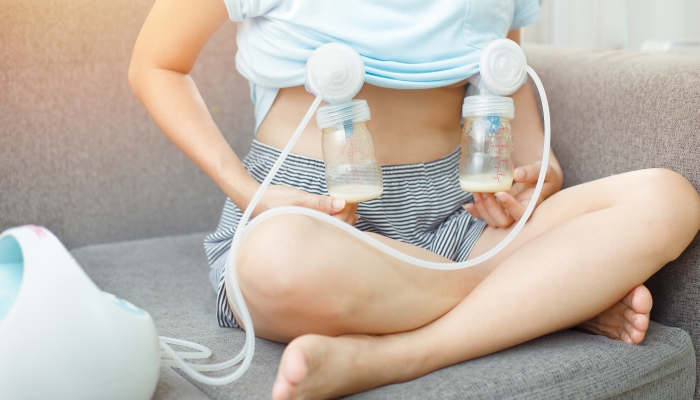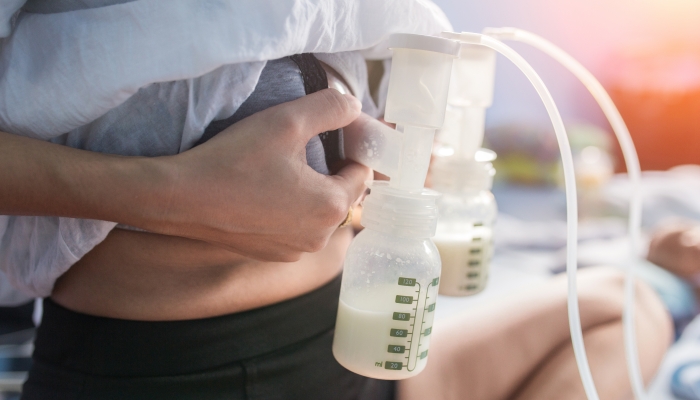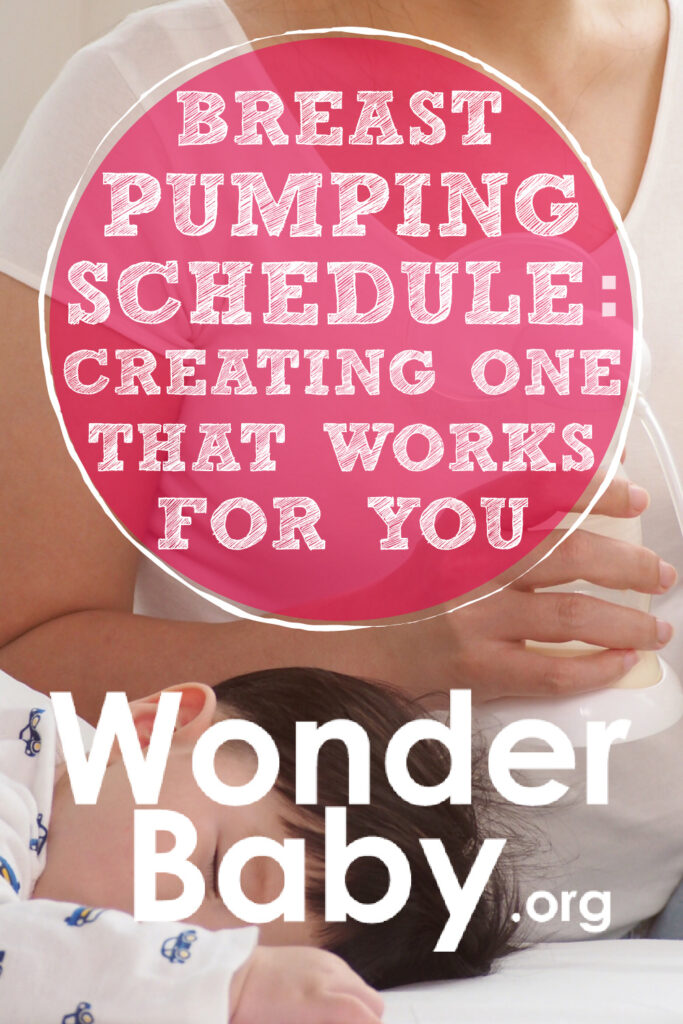Breast Pumping Schedule: Creating One That Works for You

- A breast pumping schedule can help you maintain your milk supply and avoid engorgement or mastitis.
- Pumping schedules should have you pumping consistently every few hours throughout the day.
- If your milk supply is dropping or you feel engorged, you may have to put sessions closer together.
- Your pumping sessions can spread out as your baby gets older or starts to eat solid foods.
Pumping is a great option for mothers who prefer not to breastfeed, want to spend some time away from their babies, or for mothers who work outside of the home.
Learning to use your pump can be tricky, and some moms find that it can be painful while they figure out the right size of flange and pump suction levels that work well for them. But as you get more comfortable with pumping, you can start working on a breast pumping schedule, and creating one that works for you.
Finding a way to fit pumping into your schedule allows you to provide your baby with breastmilk for as long as you want, even if you work outside of the home or someone else cares for your baby for long periods of time. Sticking to a good schedule will help you keep up your supply, and can even help you increase your milk supply to have some extra breast milk for emergencies.
Do You Need to Have a Breast Pumping Schedule?
Most moms can continue breastfeeding and pumping for longer if they follow a schedule. Keeping to a schedule helps keep your breast milk supply up and keeps you from getting uncomfortable by going too long in between pumping sessions.
Maintaining Milk Supply
Many mothers who decide to feed their baby by exclusively pumping or who work outside of the home will do better if they follow a pumping schedule. Remember, breast tissue makes more milk based on demand.
This means that if you pump or breastfeed less often or inconsistently, your milk production will slow down. Try to schedule pumping sessions as often as your baby would want to nurse at home.

How Important Is It to Follow a Breast Pumping Schedule?
As much as napping, feeding, and pumping schedules are helpful, they can also be impossible to stick to some days. Simple work or home problems, sick children, or even traffic jams can easily throw off an entire day’s schedule. Unexpected emergencies or a baby who wants to eat more than usual can also make it more difficult to stick to a breastfeeding and pumping schedule.
If your pumping sessions get a little off schedule, don’t worry. The most important part is that you get back into your pumping routine as soon as you can, and continue on with your breastfeeding journey. Consistency over time is more important than daily perfection.
What Does a Good Breast Pumping Schedule Look Like?
A good pumping schedule will fit into your lifestyle and help your milk supply keep up with your baby’s appetite.
How Often to Pump
The experts at La Leche League recommend pumping about every 2-3 hours while your baby is a newborn and you are establishing your breast milk supply. You can talk to a lactation consultant for specific pumping schedules. Exclusive pumping schedules will look different than pumping schedules for moms who are breastfeeding and pumping.
How Long to Pump
Each pumping session should last for about 15 minutes on each side. This means that you’ll spend 30 minutes total if you have a single breast pump, or just 15 minutes on a double pump.
How to Create a Breast Pumping Schedule That Works for You
Just like every baby is different, every mother is different. Some mothers find that pumping at work is easy, and others find it stressful. Some have adequate milk production using a breast pump while others worry about how much milk they are able to pump. Your pumping schedule is as unique as you are.
A pumping schedule should follow these rules:
- It works for you and your baby.
- It doesn’t cause you major stress.
- You pump often enough to avoid feeling engorged.
- Your milk pumped is enough meet your breastfeeding goals.
Creating Your Schedule
You can create your schedule using a few different guidelines:
- Pump at set times each day.
- Pump at set intervals each day.
- Pump every time your baby eats or takes a bottle.
Any of these guidelines can help you create an exclusive pumping schedule. A sample pumping schedule for a working mom with an infant might look like this:
- Nurse or pump first thing in the morning.
- Pump during an early lunch break.
- Pump once in the afternoon.
- Nurse or pump immediately when you return home.
- Pump or nurse right before bed.
- Pump or nurse once in the middle of the night.
After you establish milk supply, you may be able to drop your middle of the night pumping or feeding session.
Breast Milk and Formula
Breastfeeding doesn’t have to be all-or-nothing. If you struggle with low supply or are not producing enough milk to get your baby through the day, you don’t have to stop pumping. In fact, many moms find that a combination of formula and breast milk relieves some stress while still providing the baby with the calories they need and the benefits that breast milk provides.
Providing your baby with breastmilk just once a day still has huge benefits. Many mothers are able to extend their breastfeeding journey by using combination feeding.

When to Change Your Pumping Schedule
There may be times when you’ll want to start pumping more or less often. How and when you change your pumping schedule will depend on a few different factors.
Pumping More Often
Almost every new mom will experience a dip in their milk supply at some point. Whether you exclusively pump or nurse your baby between using your breast pump, there will probably be a time when you notice that your milk production slows. This can be due to stress, schedule changes, hormonal changes, or birth control.
If this happens, you may have to add power pumping sessions to your pumping schedule or pump more often. Most mothers produce the most milk in the morning and less in the early evening, so morning is often the best time to add a session to your daily pumping routine.
Pumping Less Often
As your breastfed baby grows, they will be able to drink more milk in a single feeding and go longer between nursing sessions. The same rule can apply to pumping. If you are able to produce more milk during each session, you can maintain your breastfeeding supply with fewer daily pumping sessions.
Sample pumping schedules based on your baby’s age might look something like this:
- Newborn: 6 pumping sessions per day (6:00am, 9:00am, noon, 3:00pm, 8:00pm, 01:00am)
- 3 months: 5 pumping sessions per day (6:00am, 9:00am, noon, 3:00pm, 9:00pm)
- 6 months: 4 pumping sessions per day (6am, 10:00am, 2:00pm, 10:00pm)
- 11 months: 3 pumping sessions per day (6:30am, 2:00pm, 10:00pm)
- One year: 2 pumping sessions per day (6:30am, 8:00pm)
Breast Pumping Tips
Besides creating a good schedule, you can set yourself up for success by using good breast pumping techniques and supplies.
Follow these tips to get the most out of each pumping session:
- Make sure your pump flange fits well.
- Try double pumping to be more efficient.
- Start pumping on low suction and then turn up the suction as you get milk flow.
- Try breast massage while you pump to express extra milk.
- Have a dedicated area to wash and dry your pump parts at work.
- Use your own cooler or fridge for your full milk storage bags while away from home.

FAQs
How many hours can you go without pumping?
How often you need to pump depends on your baby’s age and how much milk you produce. New moms will need to pump every 2-3 hours to establish supply and avoid getting engorged. Waiting longer than that might signal your breast tissue to make less milk or even lead to clogged ducts.
As your baby gets older and your milk supply is better established, you will be able to go longer between pumping, eventually only pumping once or twice per day.
Will pumping more frequently increase milk supply?
If you struggle with low supply, pumping more frequently can help. You can try to power-pump, or pump frequently for short sessions throughout the day to stimulate your breasts to make more milk. Your body is smart, and it will make more or less milk based on demand. Your breasts will produce milk as often as it is removed.
Does pumping help you lose weight?
Pumping alone will not help you lose weight, but it does burn a lot of calories. La Leche League estimates that a mother feeding her baby with breastmilk will burn about 500-700 additional calories per day. While this is the same as about an hour of intense exercise, many mothers report feeling extremely hungry while breastfeeding, and they consume any extra calories that they burn breastfeeding.
A combination of breast feeding, healthy diet, and moderate exercise can help you lose weight. Be cautious not to do anything too extreme, you need to save some energy and calories to help in your postpartum recovery and to care for your new baby.
Does pumping burn as many calories as nursing?
Nursing and pumping burn the same amount of calories, between 500-700 per day. Your body uses the calories to make breastmilk, and the method of milk expression does not make a difference.

The information WonderBaby provides is not intended to be, and does not constitute, medical or other health advice or diagnosis and should not be used as such. Always consult with a qualified medical professional about your specific circumstances.
Related Posts

Breastfeeding, Sleep
Sleep and Breastfeeding: A Comprehensive Guide for Nursing Moms
Many people assume breastfeeding and sleep training don’t go together, but it is possible to help your baby sleep better while continuing your breastfeeding journey.

Breastfeeding
Comfort Nursing: Pros, Cons, and How to Stop
Find out what comfort nursing is, when should you worry about it, and how to stop or limit your baby's comfort nursing (especially at night!).

Breastfeeding, Product Reviews
5 Best Breastfeeding Chairs for Nursing Moms of 2023
Whether you want a gentle rock, a smooth glide, or a cozy cuddle to soothe your baby to sleep, you’ll have your pick of the best breastfeeding chairs on the...